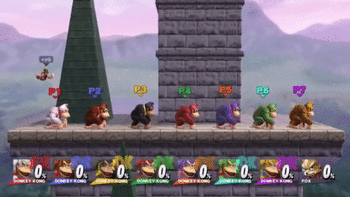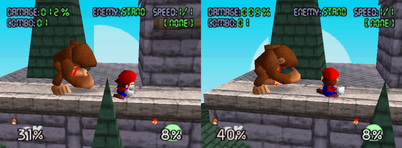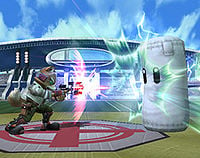Stale-move negation

Stale-move negation (ワンパターン相殺, One-pattern offsetting), known as Repetition Effect in Super Smash Bros. 4 and Stale Moves in Ultimate, is a gameplay element in all games in the Super Smash Bros. series. It refers to how moves cause less damage and knockback as they are used multiple times in a row. The strength of a move increases back to its regular power as other moves are used. Starting in Melee, being KO'd resets the staleness of all of that player's moves. Moves not yet affected by stale-move negation are referred to as fresh.
Moves are only affected by stale-move negation if they connect with an opponent or other object that can take damage, such as a crate. They also do not stale if they hit a shield, except in Super Smash Bros. Ultimate.
The purpose of stale-move negation is to discourage players from using the same attack repeatedly or over-frequently, and encourage the utilization of a character's entire moveset. However, each game in the Super Smash Bros. series handles stale-move negation differently, albeit significantly more so from the original game to Melee.
Stale-move negation is applied to the whole attack rather than individual hitboxes. As such, landing the weak hitbox will weaken all hitboxes in the attack just as landing the strongest hitbox would. Moves that are counter-attacks or absorbers do not take the stale-move negation of the incoming attack into consideration. Prior to SSB4, items are also affected by stale-move negation, even if the player drops the item they're holding and picks up a different one of the same. Any variation of the same special move counts as the same move; for example, Giant Punch shares the same staleness regardless of its charge level, or whether it is used on the ground or in the air.
Calculation in Smash 64

When a move connects in Smash 64, it is then considered stale. Any consecutive uses of the move will deal 0.75x damage; using the move more than twice in a row does not incur an additional penalty. Hitting with other moves will increase the power of the move over a sequence of three intermediate stages between "stale" and "fresh" before reaching full power.
As Smash 64 only stores damage as integers, and rounds up damage done by attacks, moves that deal less damage are less affected by stale-move negation, to the point where attacks that deal 3% damage or less are essentially immune. Weaker moves will also essentially reach full power in fewer stages; any attack that deals 24% damage or less will (after rounding up) be dealing full damage one stage before they are considered perfectly fresh.
| Stale | Level 1 | Level 2 | Level 3 | Fresh |
|---|---|---|---|---|
| 0.75x | 0.82x | 0.89x | 0.96x | 1.0x |
Using a single move as 35% or more of one's attacks during a match awards the Cheap Shot bonus, worth -99 points. The bonus is not actually connected to stale-move negation; in fact, it is possible (though unlikely) to earn it even by using two other moves in between the repeated move.
General calculation from Melee onward

Stale-move negation is calculated with a queue of the last nine moves a character has connected with. When a move is repeated in the queue, its damage is decreased an amount based on both how often the move is in the queue and how recently the move has been used - a move used seven moves ago will be slightly weaker than a move used eight moves ago, and a move used two moves ago will be weaker than both combined.
In addition to this, starting in Brawl, a move that does not appear in the queue at all gains a freshness bonus, dealing a slight bit of extra damage. As a result, attacks effectively never deal exactly their base damage - they will either be fresh and gain a bonus, or stale and take a penalty. However, the bonus for using a fresh move is usually negligible in gameplay, with the exception of special circumstances such as a fresh move being countered by a fresh counter.
The following table lists how much a move becomes weakened for each position it appears in the queue.
| Queue position | 1 | 2 | 3 | 4 | 5 | 6 | 7 | 8 | 9 | Fresh | |
|---|---|---|---|---|---|---|---|---|---|---|---|
| Reduction factor (Melee) | 0.09 | 0.08 | 0.07 | 0.06 | 0.05 | 0.04 | 0.03 | 0.02 | 0.01 | — | |
| Reduction factor (Brawl) | 0.1 | 0.09 | 0.08 | 0.07 | 0.06 | 0.05 | 0.04 | 0.03 | 0.02 | 1.05 | |
| Reduction factor (SSB4) | 0.08 | 0.07594 | 0.06782 | 0.06028 | 0.05274 | 0.04462 | 0.03766 | 0.02954 | 0.022 | 1.05 | |
| Reduction factor (Ultimate) | 0.09 | 0.08545 | 0.07635 | 0.0679 | 0.05945 | 0.05035 | 0.04255 | 0.03345 | 0.025 | 1.05 |
For example, say a move is in positions 1, 2, and 6 in the queue - it has been used two times in a row, and another time as the sixth-most recent move. In Melee, this corresponds to reductors of 0.09, 0.08, and 0.04, for a total reduction of 0.21. Therefore, if the move is used once more (and hits) without anything changing, it will deal 0.79x damage.
Using a mid-match character change (e.g. Transform or Pokémon Change) will reset the queue, except in Ultimate, where all three of Pokémon Trainer's Pokémon share the same staleness queue.
Specifics in Melee
The calculation of knockback in Melee partly ignores a move's staleness for non-projectiles. Since the knockback formula bases the knockback a player suffers on the post-damage of an attack, there is still a decrease in knockback as a move is staled, though it is extremely minimal. Typically a move will require around the same post-damage to KO regardless of its staleness value, so the additional damage needed to KO with a stale move will be around the damage dealt lost to stale-move negation (for example, a fully-staled Fox up smash will deal 9.9% damage, so it will require about 8.1% more damage than a fresh up smash to KO).
In Melee, hitting non-character targets, such as Shy Guys on Yoshi's Story, doesn't affect staleness.
Melee has the Stale Moves bonus, worth -2000 points. Like the previous game's Cheap Shot, it is not strictly related to stale-move negation: it is given to players who use one move for 40% or more of all their attacks, unless less than 16 attacks were used in total, or a single-move bonus was earned.
Connecting with a move will immediately affect it; later hitboxes of a multi-hit move will be affected by the new staleness value if earlier hitboxes connect. For example, if the first hit of the Mario Tornado connects, the rest of the hits will be one level more stale. As a result, the finishing hit of multi-hit moves can only connect as fresh if none of the set-up hits connect. As this behaviour does not make much sense, and does not seem to appear in any other Smash game, it is believed that it is unintentional.
Ice Climbers share one staleness queue. Also both characters' moves are added to the staleness queue, and thus their moves stale very rapidly. Interestingly, when Nana dies, the shared staleness queue is also emptied such that all moves become fresh, just like it is emptied when Popo dies.
Strangely, staleness is ignored when playing on debug level 3 or greater.
Specifics in Brawl
Stale-move negation is not applied in any one-player modes except for the Home-Run Contest (including Training, which initially confused those trying to test the effect); however, it is still present in the fights against Toon Link, Jigglypuff, and Wolf in the Subspace Emissary.
Unlike in Melee, the calculation of knockback no longer ignores stale-move negation. Since the damage of a hitbox is a main component in the knockback formula, this results in significant knockback loss as an attack is staled. The damage required to KO as a move is staled rises well beyond the damage dealt by it; the effect is so severe that a move that would normally KO well under 150% fresh will be unable to KO at damages over 300% if fully staled. The effect it has on KO moves means players must actively preserve the use of their primary KO moves, especially if their character has limited KO options, or else they will find themselves unable to KO opponents if they repeatedly use their KO moves without effectively refreshing them with usage of other moves. For setup moves and chain throws, the severe knockback reduction can be desirable, as it'll allow the moves to combo/chain well beyond what they normally would, and thus staling of these moves can be beneficial if exploited this way.
Also unlike Melee, Brawl protects later hitboxes of multi-hit moves from being staled while the move is in progress. This results in an unusual quirk if an attack's ending lag is interrupted by another instance of the same attack — the move is put into the queue for each time it hits, but the attack doesn't decrease in damage until the character enters a different action. For example, multiple quick hits of Meta Knight or Marth's down tilt will all deal maximum damage if initiated during the cooldown of the previous one, not decreasing in damage until the chain ends and the character enters their crouching or standing state.
Testing has shown that the Ice Climbers share one staleness queue between them, with only the leader's moves having any effect on the queue when they connect. It is currently unclear how exactly this interacts with the staleness protection above, other than Nana's move being guaranteed to have the same staleness level as Popo's under regular non-desynched conditions. It is currently unknown whether Melee also has both characters share a queue.
Specifics in SSB4
The freshness bonus from Brawl is retained, and damage calculation is altered to the point where a fully staled move will deal 0.5294x of its original damage, being higher than in Brawl but lower than in Melee. In addition, the knockback formula reduces the sum of reduction factors and freshness bonus to 0.3x of its calculated value when taking in the damage dealt, meaning that staleness is 70% less of a factor on knockback dealt. As a result, the damage dealt by KO moves will easily override the knockback loss to staleness outside of extreme cases, especially when taking the rage effect into consideration, and like in Melee, players do not need to actively concern themselves with preserving the usage of KO moves. This change also prevents the exploitation of staleness to chain a single low-knockback move well beyond normal.
In addition, staling one item will not affect another of the same item, and only the item that was actually used. This includes character-produced items such as Link's Bombs and Mega Man's Metal Blade, and as such single use items are essentially immune to staling, and since the usage of them will still enter the queue if they hit, characters that can produce items can effectively refresh their queue without having to stale other moves, when they hit another character or damageable stage element with their item.
Like in Brawl, both the stale-move negation and the freshness bonus do not apply in any single-player mode outside of the Home-Run Contest.
Specifics in Ultimate
In Ultimate, moves now stale when they hit a shield; in previous games the queue remained unchanged upon hitting a shield. Moves that stale on shield have the reductor in their queue position reduced to 0.85x, meaning that hitting shields is 15% less punishing on a move's final damage reduction for that spot in the queue.[1]
In addition, the Ice Climbers behave differently in that Nana now affects the shared queue. Popo updates the queue when the freeze frames from his attack expire, while Nana reads the queue when her attack hits. As a result, if Nana hits during Popo's freeze frames, she will share the same staleness level; if she hits after the freeze frames are over, her move will be one level more stale. Oddly, Nana does not read the queue at all if Popo hits before she acts, which means her first neutral attack will always deal base damage unless she hits alone. This oddity does not occur for item swings.
Items went under another adjustment in Ultimate. Items no longer enter the stale-move negation queue, making items unable to stale their damage or refresh other moves. The exception to this rule is attacking with battering items like Beam Sword or Home-Run Bat, which do still count as "attacks" that are added to the stale queue as their own unique action. However, throwing a battering item does not affect the queue like any other item.
Otherwise, the staleness system is generally unchanged from SSB4, though slightly stronger reductors have increased maximum staleness to 0.4695x. In addition, there is now an option in Training Mode to toggle stale moves (as well as rage) on and off, as opposed to previous games, where no such option was present. Moves will enter the queue even if the option is disabled, but will still deal their base damage in this case.
Projectiles
An unusual peculiarity of the stale-moves system is how it applies to projectiles. When a projectile is created, its staleness value is set based on the move's current staleness. This means that, if a second projectile is created before the first hits something, both projectiles will have the same staleness value. For example, firing a Blaster from long range will result in a series of beams onscreen at once, all with the same staleness value - once the first beam deals damage, the next to be fired will deal reduced damage, but the ones that already exist will not. Each shot that connects will count as one spot in the stale move queue. This behaviour exists in all five games.
The staleness of a projectile is attached to its existence as an object; simply changing hitboxes does not "re-update" their staleness. On the other hand, should a projectile self-delete and replace itself with something else (for example, when Thunder Jolt hits the ground the aerial ball is deleted and replaced with the grounded wave), its staleness value will be "re-updated". This behaviour is only confirmed in Brawl but is likely to manifest in the other games.
Controversy
While the damage reduction caused by stale-move negation is nearly the same in Brawl as in Melee, the calculation of knockback in Melee ignores it (for non-projectiles), while Brawl does not. As the damage of a hitbox is a main component in the knockback formula, this results in a much more severe drop in the knockback of a stale attack.
The much more severe stale-move negation in Brawl has had a mixed reception among the competitive fanbase. Those who support the severe stale-move negation argue that it adds more strategy and depth to the game, giving importance to "saving finishers" until the opponent is in the KO range, while rewarding those who plan the use of their attacks appropriately, and punishing those who rely on their KO attacks to rack up damage. Detractors argue that it allows some attacks to combo into themselves much more effectively than they should, resulting in them being overly powerful damage rackers at low percents. This has been the primary cause of some hard counter matchups, with the most notorious examples of such attacks being Pikachu's down throw and Sheik's forward tilt. Furthermore, the severe stale-move negation is sometimes argued to unfairly punish characters with fewer reliable KO options, such as Samus and R.O.B., as their most powerful moves will often be used too often to allow them to use them as KO options.
Some mods of Brawl alter stale-move negation, with the developers often having similar sentiments as opponents of Brawl's native stale-move negation. Some reduce its powers to varying degrees, while others remove it altogether.
As covered prior, Smash 4 drastically lessens the impact staleness has on knockback; it is now generally considered a non-factor and is thus no longer a centre of controversy.
Moves that stale-move negation does not affect
Some classes of attacks are ignored by the stale moves system; they never enter the staleness queue, so they will always deal the same damage (and cannot be used to refresh other attacks).
- Grab airs prior to Smash 4, including the Hookshot, Clawshot and Grapple Beam.
- Grab releases, such as that of Donkey Kong's cargo throw.
- Taunts.
- Items in Smash 4 (though unlike the other examples here, they enter the queue and thus can be used to refresh other moves).
- Recoil damage.
In addition, certain hitboxes appear to be immune to the stale moves system due to being attached to an object, which is attached to another object, which is attached to a character. It is believed the "signal" to alter the damage of such hitboxes is not properly propagated along such object chains. An example of this behaviour is Zero Suit Samus's neutral air in Brawl.
In Brawl and Smash 4, stale-move negation does not apply to any single-player mode outside of the Home-Run Contest. It additionally does not apply in the Online Practice Stage, and the testing mode in customization. It also does not affect matches initiated through Melee's debug menu. In the single-player and practice area cases, the freshness bonus is also ignored, so attacks always do their base damage.